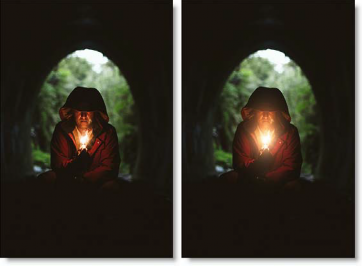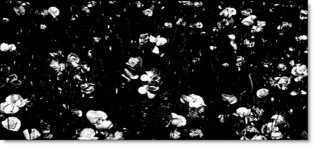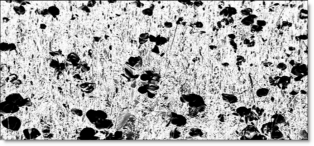The BCC+ ReLight filter allows light to be added to a scene where none existed before. A complete set of light source controls allow you to adjust the light just as you would at the time of shooting.

Before and After
Presets and the FX Editor
The FX Editor provides a convenient way to store and retrieve factory installed and/or user generated filter presets. To select a preset, open the FX Editor interface and pick one from the Presets panel. Click the apply button in the FX Editor to return to the host user interface.
To save a custom preset, click the “Create Custom Preset” icon in the top right corner of the parameter list, next to the filter name, set a name for the new custom preset in the dialog that appears and click done.
Filter Parameters
Light
Blend: Determines the blend mode to be used to add the light.
- Add: The light is added to your image.
- Screen: The light is combined with the image using a Screen blend mode. This looks kind of like the Add blend mode, but highlights are retained.
Brightness: Sets the intensity of the light.
Displacement: Displaces the light source by the luminance values of the image. This “fakes” the effect of light wrapping over objects in the image.
Blur: Sets the softness of the light.
Gels: Photographers, cinematographers and lighting designers use colored filters or gels in front of lights. Whatever mood you wish to create, we have the colors needed to achieve the effect. Select one of the Gels presets from the pop-up menu.
Color: Sets the color of the light through the use of a standard color picker.
Light Source
Blend: The light source can be added to the matte using a variety of Blend modes.
- Shape Only: Displays the light source normally, without any blending.
- Add: The pixels of one image are added to another image
- Subtract: Looks at the color information in each channel and subtracts either the blend color from the base color or the base color from the blend color, depending on which has the greater brightness value. Blending with white inverts the base color values; blending with black produces no change.
- Multiply: Looks at the color information in each channel and multiplies the base color by the blend color. The result color is always a darker color. Multiplying any color with black produces black. Multiplying any color with white leaves the color unchanged.
- Screen: Looks at each images color information and multiplies the inverse of the two images. This looks kind of like the Add blend mode, but highlights are retained.
- Difference: Looks at the color information in each channel and subtracts either the blend color from the base color or the base color from the blend color, depending on which has the greater brightness value. Blending with white inverts the base color values; blending with black produces no change.
- Darken: Looks at the color information in each channel and selects the base or blend color—whichever is darker—as the result color. Pixels lighter than the blend color are replaced, and pixels darker than the blend color do not change.
- Lighten: Looks at the color information in each channel and selects the base or blend color—whichever is lighter—as the result color. Pixels darker than the blend color are replaced, and pixels lighter than the blend color do not change.
The Multiply blend mode is ideal for combining the light source with the matte because it only puts the light source within the areas of the matte.
Opacity: Sets the opacity of the light source.
Aspect: The aspect ratio of the light source.
Radius: The un-blurred radius of the light source.
Falloff Radius: The blurred edge radius.
Falloff: Moves the falloff towards the light centerpoint.
Invert: Inverts the light source.
Transform
Transform your light pattern using Position, Scale, Rotate, Corner-Pin, Shear and Crop controls.
Crop
The image can be cropped by adjusting the various Cropparameters.
- Top: Crops the image from the top down.
- *Bottom:*Crops the image from the bottom up.
- Left: Crops the image from left to right.
- Right: Crops the image from right to left.
Corner Pin
The image can be corner pinned by adjusting the Corner Pin sliders as well as dragging the four points on the corners of the screen.
**Note:**You may need to zoom the image out a bit to see the corner points. In addition, to see and adjust the corner points in After Effects, make sure that the effect title in the Effect Controls window is highlighted. For Final Cut Pro, you must activate the cross hair icon next to the corner position parameters to see and adjust the corner points on the screen.
- Upper-Left: Controls the X and Y position of the Upper Left Point.
- Upper-Right: Controls the X and Y position of the Upper Right Point.
- *Lower-Right:*Controls the X and Y position of the Lower Right Point.
- Lower-Left: Controls the X and Y position of the Lower Left Point.
Position
Positioncan be adjusted by clicking and dragging an on-screen control in the center of the image.
- Position X: The horizontal position.
- Position Y: The vertical position.
**Note:**For Final Cut Pro, you must activate the cross hair icon next to the Position parameter.
Scale
The scaleof the image can be changed by adjusting the vertical and horizontal scale parameters.
- Scale X: The horizontal scale.
- Scale Y: The vertical scale.
- *Gang Scale:*The Scale X and Scale Y slider values can be ganged together. When enabled, the scale parameter will not display individual X and Y parameters.
Rotate
In addition to the standard position and scale controls, you can rotate. Positive values rotate clockwiseand negative values rotate counter-clockwise.
Shear
In addition to the standard position, scale and rotation controls, you can shear, or skew, the image.
- Shear X: Skews left and right.
- Shear Y: Skews up and down.
Anchor
Anchor points determine the position along the X and Y axis upon which the position, rotation, scaling and shearing occur.
- Anchor X: Defines the point on the X axis around which position, rotation, scaling or shearing takes place.
- Anchor Y: Defines the point on the Y axis around which position, rotation, scaling or shearing takes place.
Filter
You can choose the filteringmethod when applying a transform to the image. Mitchell is the default, however a number of additional filtering options are available.
- Triangle: The Triangle filter is not the highest quality, but fine for scaled images.
- Quadratic: Quadratic is like triangle, but more blur with fewer artifacts. It offers a good compromise between speed and quality.
- Cubic: Cubic is the default filter in Photoshop. It produces better results with continuous tone images, but is slower than Quadratic. If the image contains fine details, the result may be blurrier than desired.
- Catmull-Rom: This produces good results with continuous tone images which are scaled down, producing sharp results with fine detailed images.
- Gaussian: Gaussian lacks in sharpness, but is good with ringing and aliasing.
- Mitchell: A good balance between sharpness and ringing, Mitchell is a good choice when scaling up.
- *Sinc:*Keeps small details when scaling down with good aliasing.
Matte
A matte can be used to limit the area of added light. Wherever there is white in the matte is where the light will be added. When using ReLight, it is usually helpful to blur the matte.
Note:Light Source > Blend must be set to something other than Shape Only for the Matte controls to be active.
Extract On: allows for the selection of the type of matte. Select whichever type isolates the desired values. A matte is created based on one of the following:
- Luminance: A matte is created based on the luminance of the image.
- Hue: A matte is created based on the hue of the image. When adjusting the Position parameter, you are selecting different hues.
- Saturation: A matte is created based on the saturation of the image.
- Average: A matte is created based on the average of the image’s RGB values.
- Red: A matte is created based on the image’s red values.
- Green: A matte is created based on the image’s green values.
- Blue: A matte is created based on the image’s blue values.
- Cyan: A matte is created based on the image’s cyan values.
- Magenta: A matte is created based on the image’s magenta values.
- Yellow: A matte is created based on the image’s yellow values.
Position: Pinpoints the color values to be used in the matte. For a luminance matte, a Position value of 100 would make a white matte of the highlights and a value of 0 would make a white matte of the shadows. In the flower image below, look at how the matte varies for different Position values in a red extraction. When the Position is at a value of 100, the red flowers are shown as white in the matte.

Position=100, Range=25
When the Position is moved to 50, the red flowers turn black.

Position=50, Range=25
**Range:**Increases or decreases the range of values in the matte. A low Range value indicates a narrow range of values. A high Range value indicates a large range of values included in the matte.
Blur: The matte is blurred by a quality blur.
PixelChooser: The BCC PixelChooser provides a way for the user to select which pixels in the filtered source are actually going to be affected by the filter, via the generation of image based mattes, gradient mattes and vector shape masks. Mocha planar tracking and vector shape masking options are included in the PixelChooser, which allows for the generation of motion-tracked mask shapes as a hold-back mask.
For more information on the PixelChooser, Click Here.
Working with The Filter
- Apply BCC+ ReLight from the BCC Lights unit category.
- Using the Light Source > Transform controls, you can transform the shape.
- In the Light menu, adjust the Brightness, Displacement, and Blur of the light.Adding blur to the light makes the light glow.
- To apply a custom light color to the image, click on the Light > Color box and select a color.
- To choose one of the Gels, select one from the Light > Gels pop-up menu.
- Combine the light source with a matte by changing Light Source > Blend from Shape Only to Multiply.I like the Multiply blend mode because it only adds the light source in the areas of the matte.
- Change your View selector to Matte to see the matte values.The default Matte settings are preset to a highlight matte to create the light effect. If you are not seeing sufficient light, your matte should be adjusted. The areas that are white in the matte are the areas where light will be added into the image. The location of the light within the scene can be adjusted by changing the Matte > Position and Range parameters.
- Change the Matte > Position parameter if you want to select different values to be used for the light.
- Increase the Matte > Range value to add more light into the scene. Decrease for less light.
- Change the View selector from Matte to Output.
- Increase the Matte > Blur parameter to soften the transition areas of the matte.
- Click the Apply button to return to the host application.
The values of the parameter adjustments in the FX Editor user interface are transferred to your host application.








